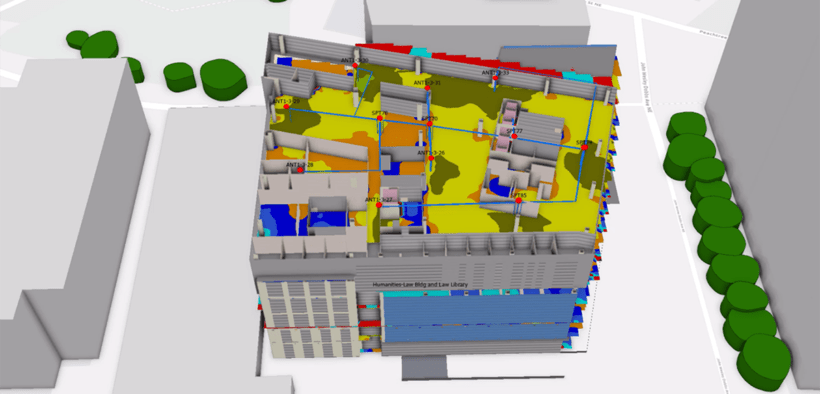Transforming Wireless Network Management with Digital Twins
Share

Digital twins are revolutionizing how wireless networks are managed, offering new opportunities for proactive planning and optimization. By creating virtual replicas of physical networks, digital twins enable telecom operators, system integrators and enterprises to track performance, predict issues, and optimize network design—without the need for costly trial and error.
What Are Digital Twins in Wireless Networks?
A digital twin is a virtual representation of a physical network, which mirrors real-world conditions. This technology allows network engineers to visualize, monitor, and simulate network behavior in real-time, all within a virtual environment.
Benefits of Digital Twins for Wireless Network Management
- Proactive Issue Detection
Digital twins enable real-time tracking of network performance. Operators can identify problems like congestion, outages, or performance bottlenecks before they affect users. This approach helps avoid downtime and improve customer experience.
- Streamlined Network Design
Digital twins simplify the design process. Engineers can simulate various network configurations and scenarios, optimizing coverage, reducing interference, and improving capacity—before any physical work is done.
- Efficient Testing and Simulation
Engineers can run simulations on a digital twin to test the impact of different variables—such as equipment changes or network expansion—on network performance. This allows for more data-driven decision-making, minimizing risks and reducing costly adjustments.
- Faster Deployment and Reduced Costs
With accurate, virtual models of the network, deployment becomes more predictable and less prone to error. The ability to visualize potential issues in advance reduces delays and ultimately lowers the cost of deploying or upgrading networks.
Real-World Use Cases for Digital Twins
- Oil and Gas Industry
In sectors like oil and gas, where wireless coverage is critical for real-time data transmission from remote locations, digital twins allow operators to design and monitor networks across vast, challenging terrains. By modeling environmental factors like weather or interference from machinery, they can optimize connectivity in remote locations, ensuring constant, reliable service.
- Smart Cities
In smart city deployments, digital twins enable planners to model the entire urban environment. From traffic management to public safety, digital twins allow for optimizing the network to meet the diverse needs of a city, ensuring every area remains connected, even in densely populated or high-traffic zones.
- Warehouses and Distribution Centers
For large-scale operations like warehouses, digital twins offer detailed models of the facility’s wireless coverage. This helps identify dead spots or areas of high traffic, allowing operators to optimize network placement and improve overall efficiency, even as inventory and operational needs change.
- Other Industries
Digital twins can also be applied in industries such as mining, manufacturing and large-scale enterprises, where complex environments and remote locations require optimized wireless networks to ensure reliable connectivity and operational efficiency.
- Any Venue Requiring Wireless Connectivity
Digital twins can be leveraged in venues requiring reliable wireless connectivity, from stadiums and convention centers to airports, hospitals, educational campuses, and commercial buildings. By modeling the physical attributes and usage patterns of each venue, digital twins help network planners anticipate demands, identify challenges, and optimize coverage.
Whether ensuring seamless streaming at sporting events, supporting healthcare communications, enhancing educational connectivity, or maintaining operations in commercial facilities, digital twins offer a versatile solution for virtually any location’s wireless needs.

iBwave Unity: Empowering Wireless Network Management
With iBwave Unity, operators, system integrators and enterprises can unlock the full potential of digital twins. This platform integrates network design, monitoring, and optimization, providing a unified solution for managing wireless networks.
- Real-Time Monitoring
Unity enables the continuous tracking of network performance, making it easy to identify and resolve issues in real-time.
- Optimized Network Design
Using Unity’s digital twin capabilities, engineers can simulate various network scenarios, helping to optimize coverage and capacity before deployment.
- Centralized Collaboration
Teams can work from the same digital model, reducing errors, improving collaboration, and speeding up network rollouts.
With iBwave Unity, network operators can build, manage, and optimize their wireless networks with greater confidence, speed, and efficiency.
Watch a demo to see how you can leverage Digital Twins with iBwave Unity:
Check out our blog for more tips and topics about wireless networks and their planning, or read our eBook to learn more about digital twins.
- Transforming Wireless Network Management with Digital Twins - April 2, 2025
- Top 3 Trends Shaping Network Design in 2025 - January 17, 2025
- Streamlining Network Design with GPU-Accelerated Predictions - May 21, 2024





















